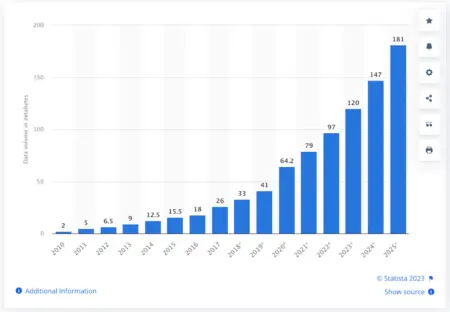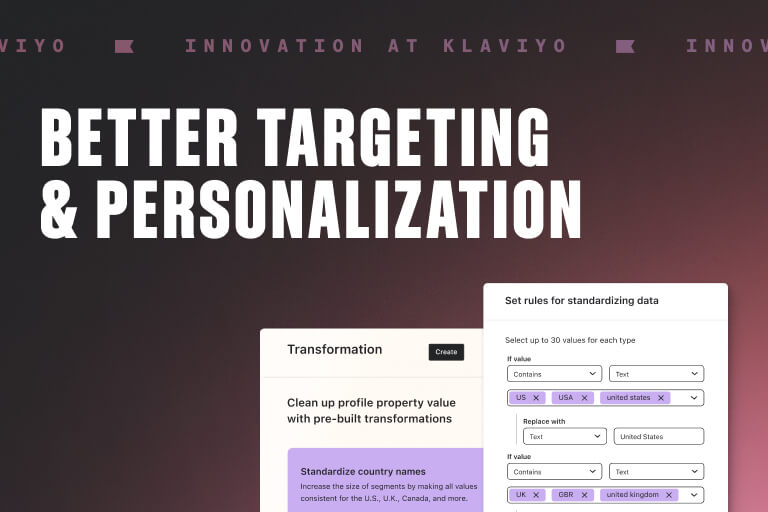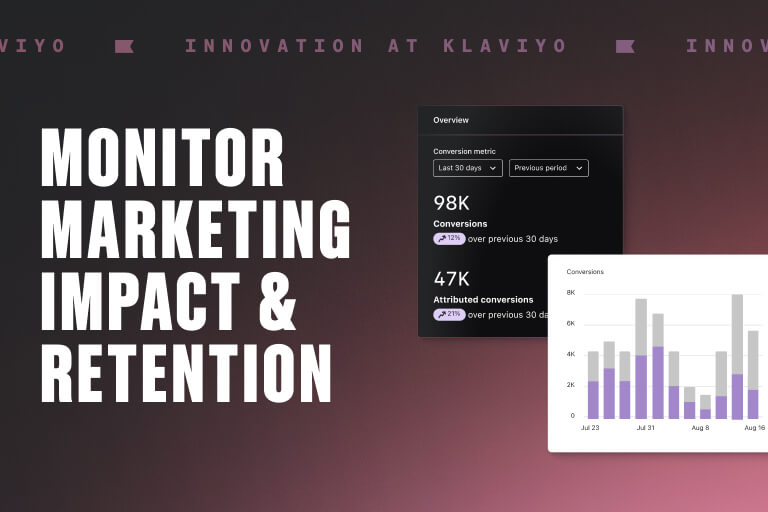Beyond “data in, data out”: What is a customer data platform (CDP)?
Unlike old-school advertising, which targeted devices, modern marketing builds outreach around people.
And people want to feel seen, not targeted.
Companies that excel at personalization in marketing generate 40% more revenue from related activities than average players, according to McKinsey & Company—and while 71% of consumers expect personalization from the brands they interact with, even more (76%) get frustrated when they don’t get it.
But while 78% of ecommerce executives understand personalization at scale is a must-have in marketing, 41% say they cannot execute all the personalized marketing tactics they deem important, Klaviyo research finds.
Why?
The answer lies somewhere in the massive amounts of data and information businesses create, capture, copy, and consume every year (up to 97 zettabytes in 2022, according to Statista).

Every time someone interacts with your business, from opening an email to refilling a subscription from your ecommerce store, they leave you a clue about who they are in relation to your brand—what makes them click, what makes them bounce, and what makes them buy.
A tech stack built for omnichannel experiences uses those clues, or data points, to deepen your relationships with customers and prospects by engaging them with personalized experiences that feel 1:1.
When it’s working, that kind of synchronicity optimizes acquisition, builds loyalty, and drives retention. But it’s impossible if your marketing efforts are based on a delayed fraction of everything your business knows about the people who interact with it.
Personalization is a topic we’ve talked about in our industry for the last 7-8 years, but it’s still a pretty hard vision to achieve.
“Personalization is a topic we’ve talked about in our industry for the last 7-8 years, but it’s still a pretty hard vision to achieve just because data is all over the place and brands don’t have a true understanding of their customers,” says Olivia Yuan, co-founder of Shopify-focused agency Tomorrow.
“Effectively, everybody has the same end goal—to create a clear picture of what their customers are doing and who their customers are,” agrees Justin Ragsdale, VP of business development and corporate strategy at full-service digital agency IM Digital. “But data is being siloed out in all of these different platforms, which creates really a muddied profile of who the customer is and what they’re doing.”
Data is being siloed out in all of these different platforms, which creates really a muddied profile of who the customer is and what they’re doing.
CDPs, Ragsdale says, “have been instrumental in evolving the way brands interact with their consumers and evolving the way we think about the customer experience.”
In other words, a CDP can usher your business into the future of online commerce—and help you build the experiences your customers are looking for.
Read on to learn what a CDP does, the main types of CDPs, and more.
What is a CDP?
A customer data platform, or CDP, is a system that collects, unifies, and stores customer data from multiple sources at scale, and makes it available for manipulation and distribution to systems of insight and engagement.
“Customer data” may include behavioral data, such as information about actions someone has taken on your website or app; transactional data, such as information about someone’s past purchases or returns; and demographic data, such as someone’s name, location, and age.
“Systems of insight” may include tech like your customer relationship management (CRM) platform, ecommerce platform, and analytics solution, while “systems of engagement” may include tech like your marketing automation platform, advertising platform, and customer service solution.
Depending on the CDP, these systems of insight and engagement may be native or external (bonus points when they’re native). Either way, a CDP ties it all together, eliminating data silos in the all-important layer of your tech stack that powers customer engagement.
But that’s just the nutshell version. Although CDPs have been around for over a decade, the term still means something slightly different depending on who you’re talking to—and what type of CDP they’re talking about.
OK, so what does a CDP actually do?
According to the CDP Institute, a vendor-neutral organization dedicated to helping companies manage customer data, a CDP is “a packaged software that creates a persistent, unified customer database that is accessible to other systems.”
Let’s break down each of those components:
- A packaged software: A CDP is a software that’s purchased from a vendor or agency and controlled by business users, frequently in marketing.
- Unified customer database: A CDP captures data from multiple systems, both internal and external. Through a process called identity resolution, it attributes customer information to a unique profile, or single customer view, and stores this information so that a business can track customer behavior over time.
- Accessible to other systems: A CDP is not a closed system. The data in a CDP is accessible to other platforms for analysis and/or to help manage customer interactions. Think of it as a data pipeline—different types of data can flow in and out. You can access the data through APIs, database queries, and file extracts.
Essentially, a CDP collects data from a variety of sources and then merges that information into a single customer view or profile. The CDP consolidates, and de-duplicates where necessary, customer information—ideally, without an IT team intervening and doing it for you.
It’s about ingesting data from multiple different sources, unifying it into single customer profiles, manipulating it, and governing it, so that you can take action on it through marketing and analysis.
Anthony DelPizzo, lead product marketing manager, Klaviyo CDP, summarizes the work of a CDP this way: “It’s about ingesting data from multiple different sources, unifying it into single customer profiles, manipulating it, and governing it, so that you can take action on it through marketing and analysis.”
The 3 main types of CDPs
To help orient you to the nuances of the CDP landscape, here’s an overview of the 3 main types of CDPs:
1. Data CDPs
CDPs in this category focus on either (rarely both):
- Standardizing all company data for purposes of data quality, normalization, governance, and access
- Eliminating the data headaches and limitations that traditionally accompany legacy email and marketing solutions, which tend to be restrictive in the types and volume of data they can accept
The primary purpose of a data CDP focused on the first bullet is to make it easier to collect data once, transform it as necessary, and make sure it gets wherever it needs to go. Analysis and activation focus, here, is minimal.
“These CDPs do a lot of really good things around data management, governance, quality, and normalization. As far as data in, data out, they’re best in class,” DelPizzo says—which makes them ideal for “businesses that have enterprise needs around data governance, data privacy, and really robust online and offline customer identity resolution.”
As far as data in, data out, they’re best in class.
However, “they don’t really do much on the analysis and activation side,” DelPizzo points out. “They’ll send data to other systems, but you can’t report on it as effectively, and you definitely can’t send marketing from them.”
They’re also “very complex and require a lot of IT resourcing,” DelPizzo adds.
The primary purpose of a data CDP focused on the second bullet, by contrast, is orchestration of omnichannel personalization and customer engagement via marketing automation, product or content recommendations, and more.
They tend to be expensive and complex to use, and for those that have them, their marketing channels are weak.
But although they incorporate marketing options, these data CDPs tend to be “expensive and complex to use,” DelPizzo observes, “and for those that have them, their marketing channels are weak”—which explains why so many businesses that use these types of CDPs also tend to purchase a separate, best-in-class marketing solution.
Examples of data CDPs include:
- Segment
- Tealium
- mParticle
- Simon Data
- Treasure Data
- Bloomreach
2. Marketing cloud CDPs
CDPs in this category are the result of efforts from well-established enterprise software companies to shift their integrated suite value propositions to a more open and flexible embrace of enterprise data.
The primary purpose of a marketing cloud CDP is to vertically integrate with other tools in the cloud provider’s technology ecosystem, and to gain access to enterprise-level feature sets such as robust security and governance.
But although these tools are sold in conjunction with the rest of a vendor’s products, they are often shoehorned into deals out of convenience—not because they are functionally the best option.
It’s basically equivalent to buying a CDP, marketing platform, and analytics tool from 3 separate companies.
DelPizzo points out that although many enterprise software companies make claims of seamless vertical integration across their offerings, “many of these suite tools have been piecemealed together through acquisitions, so they’re not built on the same infrastructure. They’re super complex, and they’re not actually that well integrated.”
“It’s basically equivalent to buying a CDP, marketing platform, and analytics tool from 3 separate companies,” agrees Nick Kobayashi, group product manager at Klaviyo.
Examples of marketing cloud CDPs include:
- Adobe Real-Time CDP
- Data Cloud for Marketing by Salesforce
- Oracle Unity CDP
3. Analytics CDPs
CDPs in this category provide data management plus analytical applications, including advanced customer segmentation. Applications may also extend to machine learning, predictive modeling, revenue attribution, and journey mapping.
The primary purpose of an analytics CDP is to enable cross-functional data insights, reporting, and analysis.
Examples of analytics CDPs include:
- Lexer
- Amperity
- Amplitude
What a CDP isn’t: CDPs vs. other software solutions
As Kobayashi points out, “there are a lot of different softwares that handle customer data.”
CDPs, he explains, “grew out of the need to actually bring all that data together, where you’re using different systems that different teams are managing.”
Here’s how a CDP fits into your martech stack, compared to those other systems:
CDP vs. CRM
This one can be a bit confusing, because the two softwares “serve a lot of similar use cases,” DelPizzo admits.
But broadly speaking, he says, a CRM system “focuses on account-level B2B data—sales contacts, business-level contacts, interactions with sales and customer service teams, and centralizing that account-level data so that you have single account-level views.”
By tracking the pipeline of potential sales, CRMs enable businesses to forecast future revenue. As a result, marketers are not usually the primary users of this kind of system—customer service or sales teams are.
The central data objects in a CDP, by contrast, are customer records. Unlike a CRM, a CDP can identify customers and prospects from information collected across multiple sources and create a unified customer profile from millions of data points.
A CRM focuses on account-level B2B data. A CDP is often serving B2C use cases.
A CDP, then, “is often serving B2C use cases,” DelPizzo explains. And while many upmarket CDPs incorporate account-level data, he adds, “it’s not their primary function.”
In other words, whereas the data in a CRM tends to be more relational, focused on customer interactions with your team, the data in a CDP tends to be more behavior-based, focused on customer interactions with your product or service.
Sometimes, a CRM is used as an input and output channel for a CDP because the CDP can provide a more holistic data set to the CRM. But unless a B2C business works with a lot of different distribution channels and other business partners, “a CDP would be their primary need,” DelPizzo says.
CDP vs. marketing automation platform
The primary difference between traditional CDPs and traditional marketing automation tools, DelPizzo says, is that the latter usually “aren’t built to centralize your customer data. They’re built to send marketing.”
“Most marketing automation platforms need data from somewhere else, like your ecommerce platform or your CDP, in order to send marketing,” DelPizzo explains. “More and more tools are adding capabilities to ingest data, but it’s still not their primary focus.”
Most marketing automation platforms need data from somewhere else, like your ecommerce platform or your CDP, in order to send marketing.
Traditional CDPs, meanwhile, “collect data, but they’re not sending the marketing,” DelPizzo says. “Or, if they do have marketing channels, the marketing channels are often really weak or unsophisticated.”
Think of it this way: Whereas a traditional marketing automation platform handles the marketing, a traditional CDP fuels the marketing.
CDP vs. data warehouse
A data warehouse collects and stores data, mainly to support analytics, reporting, back-up, and recovery. But it doesn’t process its raw data to make it usable or actionable.
Unlike a CDP, you don’t use a data warehouse to drive customer engagement or interactions. There’s no identity resolution within a data warehouse, so you can’t identify customers across different channels or devices.
Data warehouses are designed for analysis and data storage, which is why many businesses that have CDPs often use a data warehouse as a separate repository and a back-up.
A data warehouse is also updated less frequently than a CDP, which can ingest data in real time and make that information available almost instantly through APIs or data queries.
DelPizzo puts it this way: “CDPs are designed for marketing and haven’t historically done much data storage. Data warehouses are designed for analysis and data storage, which is why many businesses that have CDPs often use a data warehouse as a separate repository and a back-up for data, in case something fails or they get acquired.”
CDP vs. DMP
A data management platform (DMP) is primarily used in advertising. It focuses on anonymized, aggregated, third-party, cookie-based data which it stores temporarily.
“Advertisers use DMPs to track, understand, and segment on people who are browsing their websites and mobile apps,” Kobayashi explains.
For 1:1 communication, DMPs aren’t helpful the way CDPs are.
A CDP, by contrast, is primarily used for marketing across the entire customer journey. It focuses on zero- and first-party data: information your subscribers and customers hand over voluntarily, and information based on observing customer behavior on your website and owned channels. A good CDP also stores your data for as long as you want.
“DMPs originally were really powerful for 1:many advertising, but as data privacy continues to get stricter and stricter, the information you’re able to get from third-party data sources is just not nearly as accurate and granular as zero- and first-party data,” DelPizzo explains. “For 1:1 communication, DMPs aren’t helpful the way CDPs are.”
CDP vs. CDH
A CDH, which stands for “customer data hub,” is defined as a software that collects, organizes, and centralizes data from various systems across the customer journey.
Huh. As DelPizzo says, “sounds like a CDP.”
The overlap between these two terms might come down to a simple matter of branding. “Some CDP-adjacent companies have tried using other names for their solutions, but ‘CDP’ is already a confusing enough term,” DelPizzo points out. “Transparently, it just ends up creating more noise in the market.”
Klaviyo CDP: the first CDP built for businesses of all sizes
Any CDP can, in theory, help you make sense of your customer data and use it to inform personalized, omnichannel marketing.
But to truly shorten the distance between data, insight, and action, you need a user-friendly CDP like Klaviyo CDP—a vertically integrated CDP that simplifies your tech stack and empowers you to more effectively manage and activate your data.
As a best-in-class marketing automation platform, Klaviyo already ingests data from a variety of sources (with hundreds of pre-built integrations), stores that data in a highly actionable way, and reveals how owned marketing channels are performing through various reporting tools.
But as the first CDP built for businesses of all sizes, Klaviyo CDP goes even further, providing marketer-accessible tools for unifying and transforming data, running more advanced reporting, and syncing data in Klaviyo with other systems—at scale.
Here are 3 key differentiators that make Klaviyo CDP stand out from other CDPs on the market:
- It shortens time to value. Klaviyo CDP:
- Is built for businesses of all sizes, not just large enterprises
- Is user-friendly and accessible to marketers of all technical skills
- Requires minimal additional set-up
- It lowers total cost of ownership. Klaviyo CDP offers:
- Best-in-class vertical integration
- Unique ability to store unaggregated, lifetime event data for every customer
- Built-in native data analysis, ingestion, syncing, and manipulation
- Lower software spend, fewer development hours, and less ongoing maintenance
- It provides fast access to unaggregated all-time and real-time data. That means:
- Granular visibility into your brand’s lifetime of data, from real-time browsing behavior to transaction behavior from years ago
- More advanced analysis and complex personalized marketing at scale
- Higher customer lifetime value (CLTV) and retention rates
- Lower acquisition costs
Because Klaviyo’s core platform is built on top of powerful data infrastructure that centralizes customer data and makes it robustly actionable for highly targeted marketing, Klaviyo CDP enables you to do more, more effectively, with the data you already have in your marketing technology stack.
Want to go beyond CDP basics? We cover everything you need to know to make sure you start from a place of value and end with loyal, lifelong customer relationships in this CDP marketing series. Check out:
- Benefits of a CDP
- CDP marketing use cases
- Questions to consider before selecting the right CDP for your business
- Best CDPs on the market
Customer data platform FAQs
What are the key challenges associated with using a CDP?
The most common CDP challenges include inability to scale, slow time to value, high operational overhead, usage difficulty, and lack of analytics or activation capabilities. When selecting a CDP for your business, pay particular attention to how the vendor addresses all of the above.
Is a CDP suitable for an SMB?
The short answer: Historically, no. Now, absolutely.
The long answer: Historically, CDPs were designed for enterprise businesses with substantial financial and developmental resources to invest in implementation, maintenance, and everyday operations—leaving SMBs with unmet needs around data storage, unification, and activation. But now, with a user-friendly CDP like Klaviyo CDP, SMBs can flexibly ingest, store, and centralize high volumes of data for real-time marketing and advanced analysis—without predefined schemas, custom development, or data scientists.
How does a CDP work?
A CDP works by pulling customer data from multiple sources together into a single customer view, resolving identities between sources, and activating (or sending) data either natively or across other external systems.



